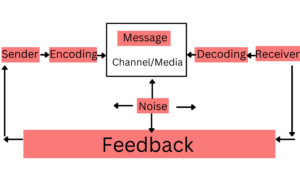Understand what is feedback in communication with real examples and feedback processes. In addition to the importance, types, and effectiveness of feedback.
Feedback definition in communication
“Feedback is the process of providing information to an individual or group to help them understand the effectiveness of their actions and the impact they have on others.” – Peter Senge
What is Feedback in Communication?
Feedback in communication is the valuable information or response conveyed from the receiver back to the sender of a message. It helps in conveying how well the message was understood and received. Feedback is a crucial element in communication as it enables the sender to evaluate and adjust their message accordingly.
Feedback can take various forms including:
- Verbal: Such as a spoken response or a comment.
- Non-verbal feedback: Including facial expressions, body language, or gestures that indicate the receiver’s reaction.
- Written feedback: In the form of emails, messages, or notes.
Feedback in communication serves the purpose of fostering clarity and promoting mutual understanding between the sender and receiver. It helps the sender measure whether their intended message was successfully transmitted and if any adjustments or clarifications are needed. Additionally, feedback allows the receiver to express their thoughts, opinions, or questions related to the message.
Feedback Process in Communication
The feedback process in communication involves a series of steps that occur between the sender and receiver. Here’s a brief explanation of each step:

The process of feedback contains the following:
1/ Sender conveys a message: The sender initiates communication by transmitting a message, whether it’s spoken, written, or non-verbal.
2/ The receiver receives the message: The receiver perceives and receives the message from the sender through various channels.
3/ The receiver provides feedback: The receiver formulates a response or reaction to the message. This can be in the form of verbal or non-verbal feedback.
4/ Feedback is conveyed: The receiver communicates their feedback back to the sender, indicating their understanding, interpretation, or reaction to the message.
5/ Sender receives the feedback: The sender receives the feedback from the receiver, whether it’s in the form of verbal acknowledgment, body language, or written response.
6/ Evaluation and interpretation: The sender evaluates and interprets the feedback received, considering its content and context.
7/ Adjustments are made: Based on the feedback, the sender can modify their message, clarify any confusion, or provide additional information if needed.
8/ The communication cycle continues: The sender incorporates the feedback into their subsequent messages, and the process of communication continues, with ongoing feedback loops.
In communication, the feedback process forms a continuous cycle that facilitates mutual understanding and enables the effective exchange of information between the sender and receiver. It helps in refining and improving communication by addressing any gaps or misunderstandings that may arise during the interaction.
Importance of Feedback in Communication
There are numerous advantages of feedback in communication. It is an essential part of an effective communication cycle. Good communication requires an exchange of information between a sender and receiver. Without feedback, two-way communication is not possible.
Here’s why feedback is of utmost importance in communication:
1) Let the sender know a message has been received: The feedback mechanism in communication is important as it confirms the reception of the message by the intended target.
This helps the sender know the channel of communication they used was efficient in delivering the message to the receiver.
2) Helps in decision-making: Whether it is positive or negative, feedback is an important catalyst in the decision-making process.
Positive feedback helps in letting the businessperson know if customers are satisfied with their products/services. Negative feedback is also helpful as it can be used as constructive criticism to improve and make necessary changes.
3) Feedback directs performance: In a company, feedback helps maintain a sense of accountability in its employees.
If a subordinate does a task incorrectly or fails to achieve the desired objective, they are given feedback based on their performance. They can use this feedback to learn and aim for better results in the future.
4) Feedback increases engagement: A good manager understands the use of feedback. They allow suggestions from workers in order to get creative ideas and boost work enthusiasm. When employees know their input and contribution of ideas are taken into consideration, they feel engaged.
This ultimately improves the quality of the work done as subordinates feel their suggestions matter in the decision-making process.
5) Serves in communicating effectively: The feedback loop allows the sender to identify possible gaps in communication. This information can be used to improve the effectiveness of future messages.
The sender can make necessary changes to how they deliver the message, the channel they use for a particular target audience, tone, timing, etc.
Examples of feedback in communication
Example 1.0: feedback given by management
After giving a presentation, a colleague approaches you and says, “Great job! Your presentation was clear and easy to follow.” This verbal feedback acknowledges your effective communication skills and provides positive reinforcement.
In a team discussion, a team member expresses their disagreement by saying, “I understand your point, but I have a different perspective on this matter.” This feedback offers an alternative viewpoint, promoting a constructive exchange of ideas.
During a business meeting, a participant raises their hand and asks for clarification on a specific point discussed. This question serves as feedback, indicating a need for further explanation or understanding.
Example 2.0: Positive and developmental feedback
Example of Positive Feedback:
“The budget estimates you presented at the last staff meeting were very detailed and gave us good criteria for decision-making.”
Example of Developmental Feedback:
“My expectation was that you would provide us with more details on the event budget. Because we didn’t have enough information, we won’t be able to make our final decisions until later this week. What can you do to ensure that we will have the correct information?”
Example 3.0: Feedback for “Effective Communication Skills” Training
The below mention examples are real feedback given by corporate professionals after attending communication skill training.
This trainer is excellent. The training was really helpful. This will definitely enhance and improve my output, my carrier & also my personal life. – P. Vijayakumar, Asst. Manager – PMT, Mando India Steering System Pvt Ltd.
The program was informative and gave light on the required areas to be known for good communication. – Ms. Nivitha Nantakumar, Management Trainee, Lite-On Mobile India Pvt Ltd.
Excellent and most useful training. Improved communication skills. This training improved my self-confidence. – V. Vijayakumar, BEML, KGF
Overall the training program is good and it will help a lot in the implementation of our daily official duties and effective communication skills. The duration of training must be more so that it can be more effective. – Mr. Firdose Pasha, BEML, KGF
Types of Feedback in Communication
There are three types of feedback in the communication process.
1) Informal Feedback: In the work environment, informal feedback comes mainly in the form of one-on-one conversations with peers, managers, subordinates, etc.
This is a direct form of feedback in the form of an interaction using methods of feedback such as oral or written feedback. Informal feedback is spontaneous in nature. This type of feedback can be perceived positively or negatively based on the perception of the person receiving it.
2) Formal Feedback: This type of feedback is usually offered after making an observation for a long period of time. It can be directed towards an employee, studying market trends for a product or the company’s performance as a whole.
It targets studying performance over a period of time and providing a feedback report to keep what is working and discard what is not working. Examples of formal feedback can be work surveys, performance appraisal processes, etc.
3) 360-Degree Feedback: Also known as multi-source feedback, this type relies on collecting data from a number of people part of the organization (supervisors, subordinates, customers, suppliers, etc).
It is an effective form of feedback as multiple perspectives from several people are channeled into analyzing and improving performance across different areas.
Principles of feedback in communication
1. Feedback should be descriptive and specific:
Feedback should be given with the aim of changing individual behavior. Therefore feedback should be descriptive with a plan of action and should avoid generic responses such as, good or bad. A plan of action should be prepared based on observation rather than personal viewpoints.
2. Feedback must be given in a timely manner:
Feedback provided on time helps the receiver to evaluate his performance and make the changes before it is too late. The receiver should also make sure to take action as soon as the feedback is given by the superior to see the changes.
3. Feedback should be for the receiver’s benefit:
The ultimate goal of feedback is to positively impact the receiver’s behavior, therefore positive feedback should not only include the good contribution but also include areas of improvement. The giver should make sure that the feedback is not given to make the receiver feel better but for reinforcing a positive change in action.
4. Feedback should aim at providing crucial information:
As much as giving feedback is important, the giver should also make sure that the feedback should not become a burden for the receiver. That is why feedback should only include crucial information which requires immediate action. After giving the feedback the giver and the receiver should make sure they are on the same page and there is no room for misinterpretation.
5. Feedback follow-up should be made:
Feedback is not a one-time process, timely follow-up on the feedback should be taken to track the progress of the receiver. The ultimate goal of the feedback will only be accomplished after the change in the individual’s behavior.
Effective Feedback in Communication
Effective feedback is achieved when the receiver understands the message as the sender intended. Positive feedback offered by the receiver can be used as positive reinforcement and negative feedback as constructive criticism.
In communication, effective feedback achieves the following:
1) Completion of the communication process: Receiving feedback is a major component in the completion of the communication process. Effective communication operates on a two-way channel with a sender and receiver exchanging information with each other.
2) Getting suggestions: Feedback helps in the collection of information from the target receivers. This information is crucial for a business to identify the areas it can improve and promote growth.
3) Measures efficacy of a message: The sender can use feedback to assess how efficient the message is. By inspecting the positive or negative reaction of the receiver, the sender can identify the limitations in communication.
4) Improves manager-employee relations: Two-way communication between superiors and subordinates ensures a smooth functioning workflow. This promotes a congenial work environment where employees and managers interact with one another to create a better growth stimulus for the company.
5) Boosts work enthusiasm: In an organization, employees are given feedback in the form of performance reviews. This helps in holding the workers up to a certain standard of performance. Smart business professionals incentivize better performance which ultimately boosts work enthusiasm.
Feedback communication skills
Feedback is a crucial aspect for individuals to discuss and prioritize their areas of improvement. Therefore the feedback giver and the receiver should keep feedback skills in mind to make this process effective.
Guidelines for giving feedback:
- If possible make sure to share the feedback during the moment of the time when the observation was made. You need to put together the piece of information needed to discuss and be specific.
- Being genuine while giving feedback is the best way to progress. Individuals may notice your intention if you are not truly honest while giving feedback.
- Feedback will only become constructive when there is a plan of action involved rather than just a general interpretation.
- Follow up on the plan of action created to check progress.
- A two-way communication style should be followed to make the feedback process smooth.
- Avoid personal judgments and focus on changes in behavior while giving feedback to the receiver.
- Always ask if there is any confusion or misunderstanding during the feedback process.
- There should be a balance between positive and negative feedback to maintain effectiveness.
Guidelines for receiving feedback:
- Be patient and listen carefully while taking feedback.
- Take the negative feedback as learnings without hesitation.
- Clear any doubt during the feedback sessions.
- Repeat back what you have understood for clearing any misunderstanding.
- Discuss your viewpoint with the person giving feedback.
- Do not hesitate to ask questions if you have any confusion.
- Always be open to taking feedback for improvement.
Role of Feedback in Communication
Feedback in communication fulfills the following roles:
1) Two-way communication: Feedback achieves the completion of two-way communication. For effective communication, it is necessary for the sender to transmit a message to the receiver and gain feedback.
2) Verification of message delivery: Feedback helps in informing the sender that their message was received and how well it was understood by the receiver. Based on the feedback received, the sender can take further action.
3) Communication improvement: Depending on whether the feedback received is positive or negative, the communicator can improve the way they communicate and identify feedback barriers in communication.
4) Better coordination: Effective feedback adds significantly to the communication system in an organization. It ensures there is coordination between departments and employees.
Functions of feedback in communication
- Feedback helps in completing the communication process while making sure that the message is delivered and understood by the receiver.
- Communication feedback works as an evaluation criterion for judging the effectiveness of the thoughts, instructions, and opinions shared by the sender.
- Feedback allows the transfer of information in both directions (toward sender and receiver) which paves the way for new ideas, and processes, for moving forward.
- Feedback offers a basis for discussion and initiates planning for completing the task and objectives.
What is immediate feedback in communication?
Instant feedback is a quick form of feedback implemented by companies. The scope of feedback of this type covers communication on an individual level or the organization as a whole.
It uses modern equipment and technology such as web-based and mobile-based systems to communicate promptly and receive spontaneous feedback on queries.
This type of feedback offers multiple advantages. On an individual level, it increases employee participation as it allows them to give and receive feedback in real time.
For the organization as a whole, it helps managers study key metrics which can be used to formulate new strategies for growth based on the instant feedback received.
Feedback channel in communication
Allowing feedback streamlines the communication process and enhances the chance for improvements. Using the right channel is also crucial for getting timely feedback from the right sources. A few communication channels in communication as follows:
1) Daily, weekly and monthly meetings with departments: Timely meetings initiate brainstorming sessions within the team as well as allow executives to provide feedback after the implementation of strategies.
2) Team surveys: For greater response, team surveys are distributed within the respective departments to evaluate the effectiveness of decisions taken by the firms. These surveys can be related to employee satisfaction, company policies, change in SOP, etc.
3) On-one virtual feedback sessions: These are a direct form of feedback that takes place on a virtual platform and are usually taken up by the HR department. It helps individuals to better communicate their thoughts and ideas within the organization.
4) Email support: One of the most common forms of feedback medium which allow subordinates and their superiors to connect and resolve their queries and concern related to business as well as personal.
5) Contact form or live chat support: Contact forms are the easiest way to communicate and connect with representatives and the support team of any organization.
Feedback Methods in communication:
1) Sandwich method: This method maintains the balance between positive feedback and negative feedback. In simple terms, first positive feedback is given followed by negative feedback, and then again positive feedback is given to maintain the balance.
2) Aks Tell Ask: In this method, the receiver is asked to conduct a self-assessment, and find the areas of improvement as well as positives. The superior then tells their opinion on the areas of improvement and the things that went well. Finally the superior ask the feedback receiver for a plan of action for improving the weaker areas.
3) Pendleton method: In this method, the receiver is asked to conduct a self-assessment, just like the Ask Tell Ask method, and is been told to find the areas of improvement as well as what went well. The superior then provide their opinion on the areas of improvement as well as on the things that went well. The superior then asks the feedback receiver for a plan of action for improving the weaker areas. The last stage includes the superior adding his point of view for working on the areas of improvement.
4) OMP: The following method is described as a one-minute preceptor method of feedback. It starts with getting the commitment, collecting supportive information, understanding the principles, and re-initiating what went well.
Feedback barriers in communication
- Negative feedback creates a hurtful situation between the feedback giver and the receiver.
- Often times feedback is taken through the verbal medium of communication, which means elements like noise can disturb the flow of the feedback process hence creating misunderstanding.
- Interrupting the feedback giver often disturbs the flow of feedback, which can reduce the effectiveness of the feedback process.
Response vs Feedback in Communication
The basic difference between response and feedback is that a response is a general reply or an answer to the question asked. Whereas feedback is a personal viewpoint in a certain situation.
Advantages and disadvantages of feedback
Advantages of Feedback
1) A continuous feedback loop within the organization creates a learning culture across the entire organization. It helps individuals to stay updated and upskill their performance. In addition, constant feedback motivates employees to stay inclined toward achieving the goals of the organization.
2) Feedback helps in moving the communication forward and ensures the sender that the message has been received. Based on the feedback received, the sender will be able to understand the thoughts of the receiver through which the next course of action can be decided.
3) Effective feedback in communication encourages new ideas, opinions, and thoughts. This ultimately results in better brainstorming and collecting relevant data which can be used for future decision-making.
Disadvantages of feedback
1) In certain situations, negative feedback may not be taken gracefully, resulting in demotivation and affecting the relationship between two parties.
2) The feedback process will completely be a waste of effort and time if actions are not taken for improvisation. Moreover, the purpose of feedback needs to be clear and respondents should be informed about where and how their responses will be used.
3) Often times feedback is done using the verbal medium, therefore the sender and receiver may not be able to bring out productivity from the feedback process if they are not active listeners.
What is a communication process?
The communication process refers to the exchange of information between the sender and receiver. The sender initiates the communication process by encoding the message and finalizing the communication channel for passing the message to the receiver.
The receiver on the other end decodes the message and shares his opinion in the form of feedback. The elements of the communication process include Sender-Encoding-Message-Communication channel-Receiver-Decoding-Feedback.
Importance of the communication process
- Enhancing managerial skills: The communication process allows the sender and receiver to connect their thoughts, opinion, and responses with each other. The information encoded and passed by the sender allows the receiver to enhance their knowledge and make them learn new processes.
- A continuous flow of information: The elements of the communication process make the information flow from sender to receiver and vice versa in a continuous manner. This allows crucial information such as (companies’ objectives, SOP, and financial constraints) to get passed along between people at both ends.
- Encourage ideas & relationships: Effective flow of communication makes people more informed and encourages creative thinking. Moreover better communication leads to better understanding which creates a stronger bond among people.
Frequently Asked Questions
Q1. What are the characteristics of feedback?
Ans: Characteristics of effective feedback are:
- Specific: Effective feedback is specifically targeted and objective, instead of vague.
- Intentions: The aim of feedback is directed towards improving performance.
- Timeliness: For feedback to achieve maximum efficiency, the more prompt it is, the better.
- Clarity: Effective feedback is communicated clearly and must be understood by the receiver.
Q2. What are the benefits of feedback?
Ans: Feedback is the only way for the sender to know that the message has been received by the target audience. In a company, feedback helps in collecting key information about how well a product or service is performing in the market.
Q3. What is zero feedback in communication?
Ans: The zero feedback denotes no response from the receiver end. This may be due to the respondent being clear on the message sent by the sender and having no feedback to give in return. Sometimes managers may also not have any feedback for an employee that is performing up to the mark.
Q4. What is negative feedback in communication?
Ans: Negative feedback happens when the receiver of the message does not respond the way the sender intended. This can be in the form of declining a request, giving a negative review, refusing to cooperate, etc.



